|
 Secure Site
Secure Site
|
 |
Archive for January, 2011
 how to say no You caved — again. Now you’re stuck chairing the annual fund-raiser (or cat-sitting for your neighbor, or working late). What if you could turn down that request, that offer, that invite, and not feel so guilty about it afterward? Wouldn’t it be great if once, just once, you could stick to your guns and say no when you needed to most?
There are lots of reasons we struggle with “no.” Some feel bound by obligation or by fear of hurting someone’s feelings. Others believe they really can do it all (and hate to pass up the opportunity to try). But think about it: Almost every misplaced yes is really a no to yourself.
“When you can’t say no,” says negotiator William Ury, Ph.D., author of “The Power of a Positive No,” “you give up what’s essential to you in favor of what other people want.” You also put yourself on a fast track to a meltdown. “When you take on more than you can handle, you eventually burn out,” says Nanette Gartrell, M.D., author of My Answer Is No … If That’s Okay with You. “It’s not uncommon to develop exhaustion or even depression as a result.”
By asserting yourself in a considerate, confident way, says Ury, you can be selective about what you take on without jeopardizing friendships — a people-pleaser’s biggest fear. Try our five-step plan so that you can start saying no — and stop feeling guilty.
Five Steps to Saying No
1. Find Your Yes
Before you can even think about getting good at saying no, get clear on what to say yes to in life. If your yes is more time with your family, that will mean turning down obligations that keep you away from home. If it’s yes to better health, you’ll need to say no to late nights at work that keep you from the gym. The firmer your foundation and connection to your yes, says Ury, the less difficult it will be to say no. After all, you’ll be answering to a higher cause.
2. Buy Some Time
Whenever possible, don’t respond to a request on the spot. This keeps you from saying yes under pressure (“Um … sure I’ll host the baby shower”) or reacting emotionally to the request, especially when you’re feeling stressed out. “We can’t say no without getting a firm grip on our natural reactions and emotions,” says Ury — and that won’t happen unless you’ve taken the time to collect your thoughts.
To gain some perspective, Ury suggests getting some distance from the issue at hand physically and mentally for a few hours, or even a day. Figure out whose interests are at stake, what’s really being asked of you, and whether it makes sense to say yes. But be sure not to wait too long; leave the person hanging indefinitely, and you could damage a relationship.
3. Deliver Your No with Grace and Resolve
The moment of truth can be the most difficult of all, particularly when you’re afraid of hurting someone’s feelings. Ury suggests a “yes-no-yes” approach: First, share what you’re currently saying yes to (“My mother and I always go out for breakfast on Saturday mornings”). Then say no (“So I won’t be able to help you set up for the brunch you’re hosting”).
But don’t stop there. After you’ve turned someone down, affirm your good intentions by closing with another yes — this time, to a mutually positive outcome (“But I’d be happy to help clean up after it’s over”). In so doing, you relieve some of the frustration wrought by closing a door, while sending the message that you respect the other person’s needs.
For greater requests of your time — say, to serve on the town board or help a colleague launch her new business — be direct and to the point: You’re flattered but have decided to devote any free time to your children’s school instead. Avoid burdening the other person with unnecessary or elaborate excuses (such as how your mother moved away and can’t watch the kids). You run the risk of the other person trying to fix the situation (“Bring the kids, then!”). Plus, the more drawn-out the excuse, the less authentic it sounds — and, in the end, it’s really no one else’s business.
4. Have a Plan B
Even if the other person gets emotional or reactive after you’ve delivered your no, don’t yield under pressure — as difficult as this may seem. Instead, take a deep breath and listen attentively to his or her objections. Then, gently but firmly, underscore your no — and keep it simple and clean; no backpedaling or scrambling for defense.
What if your no is met with extreme resistance? Your in-laws insist that you spend the holidays at their home again; a colleague plays hardball in pressuring you into taking over a project. For this, Ury proposes having a Plan B. Think about what’s at stake (your time, resources, or respect) and be ready to pursue another path if your original no goes unheeded.
If your no fails to convince a pushy coworker that you can’t take on extra projects, for instance, plan to bring the conversation to a close and go to your boss with your concerns if necessary. If your sister has a habit of dropping the kids off unannounced (despite your protests that you have other pressing obligations), decide that next time she ignores your no, you will respectfully tell her you already have plans — and then leave the house. “The key here is not necessarily to leap to Plan B,” says Ury, “but to have it in mind so that, going in, you know you have alternatives.”
Note that while Plan B works wonders when it comes to isolated situations, it can also be incredibly helpful in addressing general patterns you fall into. Your Achilles’ heel might be lending money to friends and family (and forgetting to get repaid) or going weak when the nonprofit solicitors come knocking. Recognize these tendencies, and you’ll be more effective in lining up your own backup plan.
5. Cut Yourself Some Slack
Even with practice, some will always find saying no a challenge. For the dyed-in-the-wool people pleaser, there may be a twinge of guilt — and, for the overly ambitious, regret. Realize that your perennial inclination to offer help is something to be lauded, not criticized. “Be proud of the qualities that make it so hard to say no — thoughtfulness, empathy, compassion, generosity,” says Gartrell. “Without them, the infrastructure of our society would collapse.” Just bear in mind that by balancing your “pleaser” and “doer” tendencies with a commitment to your values, you’ll be stronger for it. Even better, you’ll be a more focused contributor to the people and things that matter most to you.
How to Say No
There’s more than one way to say it. Skip the excuses and opt for one of these suggestions from author William Ury.
“Not now.” This softens the blow and keeps the door open for another time.
“I have another commitment.” No other excuse required; you honor your commitments.
“Maybe I can help you find someone who can.” This shows respect and concern.
“I have a personal policy about …” And fill in the blank. By saying this, you put the focus on a prior commitment to yourself without opening the door for an argument (useful, say, when someone wants you to commit to working on Saturdays or give to a charity when you have a different one in mind).
“I don’t want to take on what I can’t fully commit to doing well.” This is a yes to higher standards.
adapted from Body + Soul, March 2008
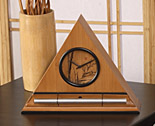 - Bamboo Zen Clock
Now & Zen
1638 Pearl Street
Boulder, CO 80302
(800) 779-6383
Posted in Chime Alarm Clocks, intention, Meditation Tools, Natural Awakening
 Healing Gems In this relaxing ritual, you’ll gather stones to stimulate the body’s seven main energy centers, or chakras, in the Ayurvedic tradition. While many massage therapists use large stones to massage out tension in muscles, simply placing stones at strategic points on the body can encourage relaxation.
On a sunny day, take a stroll along the beach to gather seven dark-colored, smooth, round stones, preferably 1 or 2 inches in diameter. Set your Zen Timer to 15 minutes. Set them down in a sunny spot and allow them to warm up for 10 to 15 minutes. When you’re ready, lie flat on your back and place a stone on each of the seven chakras (see Vital Energy Centers), one by one. Let your body relax and sink into the ground; feel the weight of each stone and the sensation it creates on your skin. Visualize energy radiating from each chakra through your body, from the top of your head through your toes. Set your Zen Timer for 20 minutes. Relax for about 20 minutes, and then remove the stones.
adapted from Body + Soul, July/August 2006
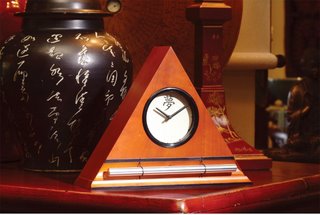 Zen Timers Now & Zen
1638 Pearl Street
Boulder, CO 80302
(800) 779-6383
Posted in intention, Meditation Timers, mindfulness practice, Now & Zen Alarm Clocks, Well-being, Zen Alarm Clock, Zen Timers
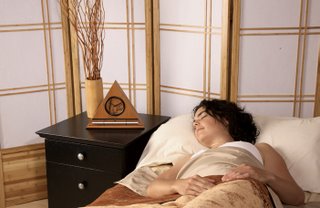 Take back your time Based in Seattle, the Take Back Your Time (TBYT) organization advocates an examination of America’s time deficit. Developed four years ago as an initiative of The Simplicity Forum (an alliance committed to achieving simple, sustainable ways of life), the group encourages people to consider their time as significant, to spend it well, and to take a stand against institutional forms of time deprivation.
As part of the initiative, the organization designated October 24 as the annual Take Back Your Time Day to bring large-scale attention to the time famine. The event helps participants in the United States, Canada, and Europe address their stress with various ideas for enjoying life — rather than rushing through it. TBYT invites you to celebrate on October 24 in the following ways.
Sleep late
Cancel something
Celebrate your spiritual tradition
Ask an older person about his or her life
Set aside one night a week for a family dinner
Enjoy some poetry
Listen carefully to children’s ideas
Reflect on the balance of labor, leisure, and consumption in your life
adapted from Body + Soul, October 2006 by Jodie Jordan
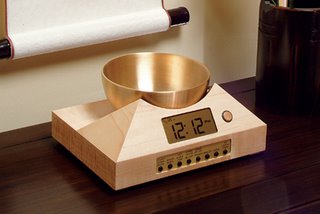 Bowl Gong Timer and Alarm Clock for a Gentle Wake UP Now & Zen
1638 Pearl Street
Boulder, CO 80302
(800) 779-6383
Posted in intention, sleep, Truth, wake up alarm clock
 pamper your feet Cold feet are one of winter’s most annoying — and common — afflictions. The answer? A rich blend of warm, wintry spices. Cayenne, cinnamon, and ginger are all circulation boosters and mild stimulants. Applied topically, they increase blood flow, relieving chill and numbness. Cayenne, in particular, has foot-warming benefits; folk wisdom suggests sprinkling the fiery pepper into socks on cold days. For a more luxurious experience, try this simple foot mask. It combines spices, skin-soothing ingredients such as oatmeal and honey, and the invigorating essence of orange.
Orange Spice Foot Mask
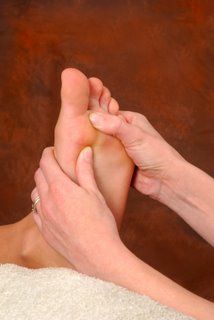 cure cold feet 1/2 cup whole oats
1/2 teaspoon cinnamon
1/2 teaspoon cayenne pepper
4 tablespoons warm water
1 teaspoon olive oil
1 tablespoon honey
1 tablespoon fresh ginger, grated
4 drops sweet orange essential oil
Food Mask How-To
1. Using a food processor, grind the oats to a fine powder. Transfer to a medium-size bowl, add the remaining ingredients, and stir until blended into a thick paste.
2. Prepare two warm, wet washcloths or hand towels, either by wetting them and placing them in the microwave for one to two minutes or by soaking them in hot (not boiling) water. Wring out excess water and set aside.
3. Sitting with your feet in the tub or a large basin, use your hands to spread a thick layer of the mask over each foot, covering them completely up to the ankles. After wiping hands clean, wrap each foot in one of the washcloths to seal in the moisture from the mask. Set your Zen Timer for 15 minutes. Set your Zen Timer with Bowl. Sit back and relax for 10 to 15 minutes.
4. When you’re ready to remove the mask, carefully lift off the washcloths. Rinse your feet thoroughly using warm water. Pat dry with a towel.
adapted from Body + Soul Magazine, Jan/Feb 2006 by Donna Garlough
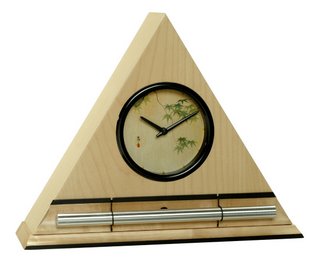 Zen Alarm Clock with Maple Leaves Now & Zen
1638 Pearl Street
Boulder, CO 80302
800) 779-6383
Posted in Chime Alarm Clocks, Well-being, Zen Alarm Clock, Zen Timers
 do it yourself facial Massaging Your Face
This is a great way to loosen muscles scrunched into habitual expressions. “This brings blood to the surface, clears out puffiness, and reduces fatigue in the skin,” says Chris Haas, owner of Ra Organic Spa in Burbank, California. Don’t have time for an appointment? At home, all you need is the following ingredients for a facial serum. Barbara Close, founder of Naturopathica, recommends a base of evening primrose and avocado oils with rose geranium, lavender, and German chamomile essential oils for dry skin, or apricot kernel oil with juniper, lemon, and rosemary oils for oily skin. How? Starting at the chin, move your hands in small circles and continue to the cheeks, around the eyes, and to the forehead. By doing this, you’re stimulating circulation and bringing more nutrients to the skin. Follow with a warm compress to increase the absorption of the serum. Here are some DIY recipes for facial serum, based on your type of skin:
For Dry Skin
Ingredients
1-ounce bottle
1/2 ounce avocado oil
1/2 ounce evening primrose oil
6 drops rose geranium essential oil
3 drops lavender essential oil
2 drops German chamomile
Directions
Fill bottle halfway with avocado oil. Add essential oils, cap bottle, and shake well. Top off with half ounce of evening primrose oil and shake again.
For Oily Skin
Ingredients
1-ounce bottle
1/2 ounce apricot oil
1/2 ounce hazelnut or jojoba oil
6 drops rosemary essential oil
3 drops juniper essential oil
4 drops neroli essential oil
Directions
Fill bottle halfway with apricot oil. Add essential oils, cap bottle, and shake well. Top off with half ounce of hazelnut or jojoba oil and shake again.
For Sensitive Skin
Ingredients
1-ounce bottle
1/2 ounce jojoba oil
1/2 ounce rosehip seed oil
3 drops everlasting essential oil
2 drops German chamomile
6 drops rose geranium essential oil
Directions
Fill bottle halfway with jojoba oil. Add essential oils, cap bottle, and shake well. Top off with half ounce of rosehip seed oil and shake again.
adapted from Body + Soul, October 2010
 Chime Timers and Clocks with Chime in Bamboo, Walnut, Maple, and Black Lacquer Now & Zen
1638 Pearl Street
Boulder, CO 80302
(800) 779-6383
Posted in Chime Alarm Clocks, intention, mindfulness practice, Well-being, Zen Alarm Clock, Zen Timers
 what energizes me? Universal fixes help, but managing your energy levels can also be a very personal process. Here’s what some whole-living luminaries do to recharge:
“To paraphrase Thoreau, my tonic is the wilderness. When I am low on energy, I go to nature, and it restores me every time. Whether I’m sitting next to a lake or canoeing in it, just being in a place where plants thrive feeds my energy.”
–Rosemary Gladstar, herbalist, teacher, and founder of United Plant Savers
“Doing deep yogic breathing, Sun Salutations to fun and upbeat rock music, and inverted poses like handstands get me going. Plus, I conserve my energy and redeploy it into the priorities of what must be done, cutting out all extraneous activities, like internal dialogue (negative and overwhelming banter), anger, frustration, and fears.”
–Ana Forrest, yoga pioneer and creator of Forrest Yoga
“My dogs walk me twice a day, and they’re the best energizer I know. There’s nothing like getting out in nature with two joyous beasts who don’t have to think twice about the meaning of unconditional love, both for me and the trail, however well beaten a track it is.”
–Kenny Ausubel, founder of the Bioneers Conference and co-executive director of the Collective Heritage Institute
 wilderness is a tonic “A frothy cup of green matcha tea and some breathing exercises help get me energized, as does an invigorating swim in my pool. Plus, looking forward to something with excitement always motivates me.”
–Andrew Weil, M.D., author of “Healthy Aging” and editor of Dr. Andrew Weil’s Self Healing Newsletter
“I love my work and get pulled in by endless to-do’s, often chugging along until I’m exhausted and ‘too-done.’ While exercise, yoga, and meditation help keep my energy high, so do regular breaks from the usual routine. I keep my knitting bag, beading box (I love to make malas and prayer bracelets as gifts), and a fast-paced mystery novel handy for 10- to 15-minute breaks three or four times a day. Letting go of responsibility to bask in creativity, or to drop into a fictional world very different from my own, keeps the juices flowing.”
–Joan Borysenko, Ph.D., psychologist and best-selling author of 12 books, including “Saying Yes to Change”
adapted from Body + Soul, September 2006
 Bamboo Zen Timer and Natural Alarm Clock with Gentle Chime Now & Zen
1638 Pearl Street
Boulder, CO 80302
(800) 779-6383
Posted in intention, Meditation Timers, Meditation Tools, mindfulness practice, nature, Walking Meditation, Well-being, zen
 Stress Cures From traffic jams to lost luggage, holiday travel can leave you frazzled. This year, get the holidays off to a stress-free start by arriving at your final destination composed and energized. Just follow these simple tips from Kate Hanley, author of The Anywhere, Anytime Chill Guide.
Stretch It Out
Where stress starts, tight muscles follow. Ease the strain of hours sitting in the sky or on the road with a simple, seated stretch Hanley calls The Number Four: Place an ankle over the opposite knee (making the shape of a four) then lean forward and rest your elbows on your shin.
Apply Pressure
If icy roads or midflight turbulence leave you with a pounding heart and racing thoughts, Hanley recommends a little acupressure. Simply curl each finger down until it touches the palm. The subtle move lessens anxiety by slowing down the heart and, in turn, quieting the mind.
Say It Out Loud
“The very act of traveling requires an element of surrender,” says Hanley. When plans go awry (a delayed flight, a missed exit) — and they will — slowly repeat the mantra “I’ll get there when I get there.” This helps you stay mindful of what’s out of your control.
Wish Them Well
With everyone rushing to get from point A to point B, you’re guaranteed to run in to someone who will ruffle your feathers. “The trick to not losing your cool,” says Hanley, “is to develop compassion.” Instead of flying off the handle at that impatient driver or curt customer service rep, try a kindness meditation. Hold an image of them in your mind and put yourself in their shoes with an empathetic thought: “I’m sure he’s anxious to see his family” or “I bet she’s had a long day.”
adapted from Body + Soul November 2009
 Zen Timer for your wellbeing practice Now & Zen
1638 Pearl Street
Boulder, CO 80302
(800) 779-6383
Posted in Chime Alarm Clocks, intention, Meditation Timers, Meditation Tools, mindfulness practice, Now & Zen Alarm Clocks, Well-being, Zen Timers
 the sleep and pain connection Waking up in the idle of the night can be a pain — literally. New research from John’s Hopkins University shows that prolonged sleep disturbances may contribute to chronic pain, most likely by hindering the body’s natural pain-control functions. The study followed 32 healthy women for a week: For three nights, one group of participants was woken up every hour for eight hours, while the rest slept undisturbed. On the following days, women in the disrupted-sleep group experienced an increase in spontaneous pain.
If you do wake up during the night, help yourself swiftly return to dreamland by breathing deeply and counting each breath. “And don’t try to recover by consuming a lot of caffeine the next day,” urges sleep specialist and neurologist Dr. Sarah Zallek. “That’s just going to make you more likely to have another bad night of sleep.”
adapted from Body + Soul 2007
 Bamboo Digital Wake Up Clock Now & Zen’s Alarm Clock Store
1638 Pearl Street
Boulder, CO 80302
(800) 779-6383
Posted in Insomnia, Natural Awakening, Now & Zen Alarm Clocks, sleep, wake up alarm clock, Well-being
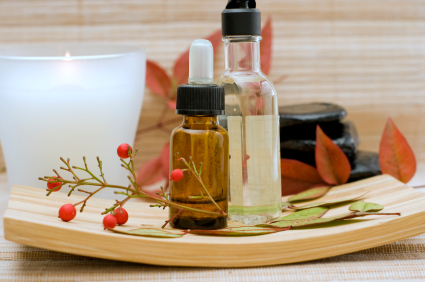 mood mists Oil and water may not mix, but in the case of essential oils, they form a divine — and useful — combination. Extracted from leaves, fruit peels, petals, and other plant parts, essential oils capture nature’s subtle fragrances and can even balance your mood, aromatherapists say.
Some, like peppermint and eucalyptus, are believed to be stimulating and uplifting; others, like lavender and frankincense, are considered relaxing and centering. These mists are the simplest way to experience aromatherapy for yourself. Spray the air around you, mist your hair and skin, or spritz them on linens to leave a light scent. (They won’t stain.) Whether you’re stressed or sluggish, one of these mists will suit your mood.
Ingredients
The Pick-Me-Up
1 drop eucalyptus (Eucalyptus globulus)
2 drops geranium (Pelargonium graveolens)
3 drops peppermint (Mentha piperita)
The Calm-Me-Down
2 drops bergamot (Citrus bergamia)
1 drop frankincense (Boswellia carteri)
3 drops lavender (Lavandula angustifolia)
To Make the Sprays
1. Fill a clean, dry mini spray bottle with 4 ounces of pure distilled water.
2. Using a dropper, carefully put the selected blend of essential oils directly into the spray bottle.
3. Tightly close the bottle and shake vigorously to combine. Be sure to shake it before each use, as the water and essential oils tend to separate.
adapted from Body + Soul, June 2006 by Donna Garlough
 Zen Alarm Clock with Maple Leaves Now & Zen
1638 Pearl Street
Boulder, CO 80302
(800) 779-6383
Posted in intention
Late autumn’s seasonal trends-dropping temperatures, fading light, and your body’s dipping defenses-invite all manner of maladies: colds and coughs, debilitating flus, and the lingering malaise known as the winter blues. But with a few herbal tinctures — simple yet powerful remedies that you can make yourself — you’ll be set up to stave off these ailments and, when they do find a foothold, minimize your discomfort and speed up your recovery.
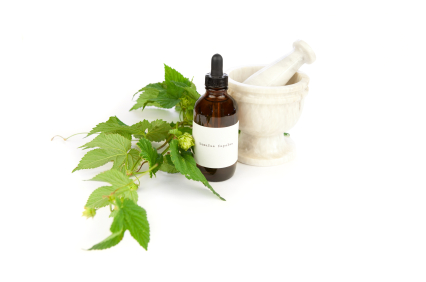 winter remedies
Tinctures, which are concentrated liquid extracts of medicinal plants, remain my favorite remedies for acute, wintertime ailments because of their sheer potency. Taken by the dropperful, they work well, and they work fast. Also called herbal extracts, tinctures have been made for thousands of years by soaking fresh or dried herbs in a solvent, such as vodka or brandy, to extract the plants’ medicinal properties. While herbal-tincture manufacturers use more complicated, exacting methods, the traditional technique is simple. It requires only easy-to-find ingredients and common kitchen tools, yet makes some of the most effective tinctures available — for pennies per dose.
Medicinal herbs can be tinctured alone — a whole-plant echinacea tincture will serve you well — or with other compatible herbs. The herb combinations here are among my most trusted, time-tested remedies. Echinacea, goldenseal, and turmeric make up Super Immune Support, my standby for fending off infections. Cold and Fever Fighter contains elder, yarrow, and peppermint to help ease colds and fevers. Cough and Sore Throat Soother features soothing, lung-supportive mullein, licorice, and wild cherry bark, plus ginger for a little zest. Garlic, onion, ginger, cayenne, and horseradish give Fire Cider its warming, infection fighting kick. And Mood Booster, for easing seasonal depression, includes hawthorn, oat tops, lemon balm, and St. John’s wort
Whether you make one of these recipes or all five, keep in mind the two essential principles of herbal medicine making. First, quality ingredients make quality products. If you can’t grow your own herbs, buy them from reliable growers or distributors. Likewise, when choosing your solvent, the medium used to extract and deliver the plants’ medicine, choose the best. Second, but just as important, intention matters. Native American healers, who used many of the herbs in these formulas, had a deep reverence for the plants’ healing powers. When they dug the plants, they did so with respect and prayer, and when they made them into medicine, they also prayed. Without prayer, they said, the plant’s medicine — its essence — stayed in the ground. Among people who use “green medicine” today, there is still a deep sense of respect for the plants. I invite you to share this feeling as you gather your herbs and brew your tinctures. In my experience, herbal remedies made with clear intention and an appreciation for the plants are much more effective.
Simple Tincture Making
1. Gather the materials.
When people first start making tinctures, they often go overboard and make gallons. But tinctures are highly concentrated and taken in very small doses — a little goes a long way. To make about a pint of tincture, you’ll need a clean, dry, quart-sized jar with a tight-fitting lid, enough herbs to fill the jar halfway, and roughly a pint and a half of solvent (the herbs will soak up some solvent). Most of my formulas call for 100-proof brandy or vodka, both excellent solvents. If you prefer not to use alcohol, you can substitute vinegar.
2. Prepare the herbs.
If you have any fresh herbs, use them. High-quality dried herbs, however, are just as potent, and available year-round. If you are using fresh herbs, rinse them with water to remove any dirt, then chop them finely. (Dried herbs are usually finely chopped when you purchase them.) Fill your jar halfway with herbs. For a strong, effective tincture, be sure the jar is densely filled.
3. Add the solvent.
Pour the solvent over the herbs until they’re completely covered, then add an additional 2 to 3 inches of solvent. The herbs must be completely submersed to prevent bacteria from growing. Cover the jar with a tightly fitting lid. Herbs often swell as they soak up the solvent; if they start to “emerge” above the liquid, add more solvent. Note: If using vinegar, as in Fire Cider, warm it on a stovetop before pouring it over the herbs; this helps facilitate the release of medicinal constituents.
4. Let the tincture sit for 4 weeks.
During the process of soaking the herbs in the solvent, the plants soften and break down (a process known as maceration), releasing their medicine. Most Western herbalists recommend letting tinctures macerate for 4-6 weeks. In Chinese medicine and several indigenous traditions, however, herbs are left to soak for months, even years. I have found that the longer tinctures macerate, the more effective they are, so consider a month your minimum. When starting the maceration process, label and date your jars so that you remember when you started.
5. Shake daily, with intention.
Shaking the tinctures while they’re soaking facilitates the breakdown of medicinal constituents and prevents the herbs from packing down at the bottom of the jar. It’s also an invitation to add some of the old magic to the science of herbal medicine. When you shake your tinctures, do so with your best healing intention. You can sing to your tincture jars, stir them in the moonlight or the sunlight, wave feathers over them — whatever you feel moved to do. Your remedies will be the better for it.
6. Strain the herbs.
After at least 4 weeks, your tincture will be ready for use. Line a stainless-steel strainer with cheesecloth or muslin, and place over a large glass jar or measuring cup. Pour the liquid slowly through the strainer. When finished straining, squeeze the herb-filled cheesecloth or muslin to wring out every drop. Reserve the liquid — this is your medicine — and discard or compost the herbs. Pour the finished tincture into a clean, dry glass jar with a tightly fitting lid; Mason jars work well, as do amber-colored glass jars (available at herb stores or online). Label your tincture with the contents and date.
7. Store the tincture properly.
When stored properly, tinctures last for years. Both light and heat can break down the medicinal components, so keep your jars of tinctures in a cool, dark place. It’s a good idea to keep a small supply of the tincture ready for use in a 1- or 2-ounce amber-colored bottle with a dropper top (available at herb stores or online).
Dosage and Use
Tincture dosage varies depending on the individual and the herbs being used. For chronic problems and for remedies you’re using as a tonic, such as Mood Booster, the general adult dosage is 1/2 to 1 teaspoon three times daily. For acute ailments, such as colds and flus, small, frequent doses are much more effective: for adults, 1/4 to 1/2 teaspoon every hour. Tinctures should be diluted in a small amount of warm water; they’re very strong tasting, so most people prefer to take them “down the hatch” rather than sipping them.
Solvents
The solvent is the liquid used to extract the herbs’ medicine. There are two solvents used in these recipes, each with different benefits.
Alcohol
A potent, effective solvent, alcohol extracts most plant constituents, including fats, resins, waxes, and most alkaloids (some of the strongest plant compounds). The body rapidly assimilates alcohol tinctures, and their effects are quickly felt. Furthermore, alcohol makes an excellent preservative, maintaining the integrity of the tincture for many years. Brandy and vodka are perfect for the traditional method of tincture making; both can be purchased at 100 proof, which provides an ideal alcohol-to-water ratio. (Water extracts many important constituents, like vitamins and volatile oils.) For preservative properties and extraction purposes, you must use at least 50-proof alcohol.
Vinegar
As a food, vinegar is completely nontoxic, and well tolerated by almost everyone. While it is not as strong or effective a solvent as alcohol (it does not break down as many plant components), it’s a good alternative for alcohol-sensitive people and for children. You can integrate vinegar tinctures into your daily diet, using them as a salad dressing (use organic apple-cider vinegar if possible). Most literature reports that vinegar tinctures have a short shelf life. My experience, however, has been that when stored in a cool, dark place, they will last for several years.
Wintertime Formulas
Note: If you have a serious condition, are pregnant, or take medication, consult your health-care provider before using these or any herbal remedies.
Super Immune Support
Take 1/4 to 1/2 tsp. per hour at symptom onset.
Solvent: 100-proof vodka/brandy
2 parts echinacea root, flower, and leaf
1 part turmeric
1 part cultivated goldenseal root (Use cultivated goldenseal; this herb has been over-harvested.)
Cold and Fever Fighter
Take 1/4 to 1/2 tsp. per hour at the onset of symptoms.
Solvent: 100-proof vodka/brandy
1 part elder flower and elder berry
1 part peppermint leaf
1 part yarrow flower and leaf
Cough and Sore Throat Soother
Take 1/4 to 1/2 tsp. per hour at the onset of symptoms.
Solvent: 100-proof vodka/brandy
2 parts mullein leaf
1 part licorice root
1 part wild cherry bark
1/2 part ginger root
Fire Cider
Take 1/4 to 1/2 tsp. per hour at the onset of a cold, or as a daily warming tonic. Makes a great salad dressing.
Solvent: apple-cider vinegar
1 part garlic
1 part onion
1/2-1 part freshly grated horseradish
1/2 part ginger small pinch cayenne
honey to taste (add to finished product)
Mood Booster
To prevent or ease the winter blues, take 1/2 to 1 tsp. three times daily.
Solvent: 100-proof vodka/brandy
2 parts hawthorn berry, plus flower and leaf if available
2 parts lemon balm
1 part St. John’s wort
1 part milky green oat tops
adapted from Body + Soul, Nov/Dec 2005
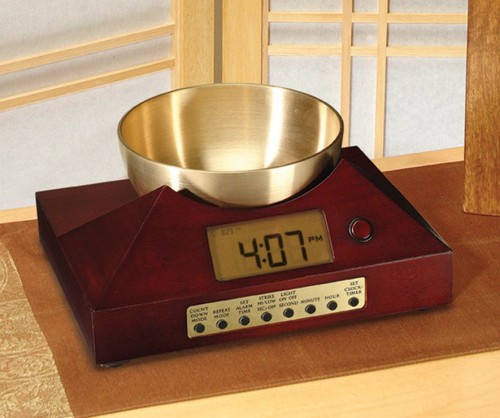 Zen Timepiece with Gong Bowl, a Timer and Alarm Clock
Posted in Zen Timepiece by Now & Zen, Zen Timers
« Previous Entries
Next Page »
|
|
|
|